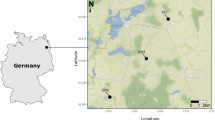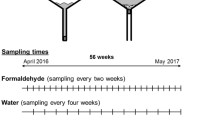Abstract
Zooplankton, and especially rotifers, have long been thought to be readily dispersed by wind, rain and animals (especially waterfowl). Given that premise, local processes (tolerance to abiotic conditions, biotic interactions) have been the main focus of ecological studies. We tested the premise of high dispersal rates by incubating particulates collected with windsocks and rain samplers at two sites over 1 year. The sites were 80 km apart and differed in proximity to water and surrounding terrain. We also incubated fecal material of wild ducks. Pond sediments were identically incubated as a test of incubation method. Only bdelloid rotifers were collected in wind samples, and only four rotifer species were collected in rain samples: Lecane leontina, Lecane closterocerca, Keratella cochlearis, and a bdelloid. No metazoans were found in incubated duck feces, yet incubated pond sediments yielded 11 rotifer, one copepod, four cladoceran, and three ostracod species. Our results do not support the premise of readily dispersed zooplankton. If zooplankton dispersal is infrequent and limited to few species, a series of other questions should be addressed on processes regulating zooplankton population dynamics and community composition.
Similar content being viewed by others
References
Berg, D. J. & D. W. Garton, 1994. Genetic differentiation in North American and European populations of the cladoceran Bythotrephes. Limnol. Oceanogr. 39: 1503–1516.
Boileau, M. G. & P. D. N. Hebert, 1991. Genetic consequences of passive dispersal in pond dwelling copepods. Evolution 45: 721–733.
Brown, J. H. & A. C. Gibson, 1983. Biogeography. C. V. Mosby Company, St.Louis, MO, USA.
Brown, A. F, 1991. Outbreeding depression as a cost of dispersal in the harpacticoid copepod, Tigriopus californicus. Biol. Bull. 181: 123–126.
Carter, J. C. H., M. J. Dadswell, J. C. Roff & W. G. Sprules, 1980. Distribution and zoogeography of planktonic crustaceans and dipterans in glaciated eastern North America. Can. J. Zool. 58: 1355–1387.
Chaplin, J. A. & D. J. Ayre, 1997. Genetic evidence of widespread dispersal in a parthenogenetic freshwater ostracod. Heredity 78: 57–67.
Connell, J. H., 1961. The influence of interspecific competition and other factors on the distribution of the barnacle Chthamalus stellatus. Ecology 42: 710–723.
De Stasio, B. T. Jr., 1991. The seed bank of a freshwater crustacean: copepodology for the plant ecologist. Ecology 70: 1377–1389.
Drake, J. A., H. A. Mooney, F. di Castri et al. (eds), 1989. Biological Invasions. A Global Perspective. SCOPE 37. John Wiley & Sons, New York, NY, U.S.A.
Frey, D. G., 1986. The non-cosmopolitanism of chydorid Cladocera: implications for biogeography and evolution. In: Gore, R. H. & K. L. Heck (eds), Crustacean Biogeography. Balkema, Rotterdam: 237–256.
Fryer, G., 1985. Crustacean diversity in relation to the size of water bodies: some facts and problems. Freshwat. Biol. 15: 347–361.
Gislen, T., 1947. Aerial plankton and its conditions of life. Biol. Rev. 23: 109–126.
Gotelli, N. J., 1991. Metapopulation models: the rescue effect, the propagule rain, and the core-satellite hypothesis. Am. Nat. 138: 768–776.
Hagiwara, A., 1995. Resting eggs of the marine rotifer Brachionus plicatilis Muller; development, and effect of irradiation on hatching. Hydrobiologia 313/314: 223–229.
Hebert, P. D. N. & B. J. Hann, 1986. Patterns in the composition of arctic tundra pond microcrustacean communities. Can. J. Fish. aquat. Sci. 43: 1416–1425.
Hebert, P. D. N. & C. Wilson, 1994. Provincialism in plankton: endemism and allopatric speciation in Australian Daphnia. Evolution 48: 1333–1349.
Hutchinson, G. E., 1967. A Treatise on Limnology. Volume II. Introduction to Lake Biology and the Limnoplankton. John Wiley and Sons, New York, NY, U.S.A.
Jenkins, D. G. & A. L. Buikema, Jr., 1998. Do similar communities develop in similar sites? A test with zooplankton community structure and function in new ponds. Ecol. Monogr. 68: 421–443.
Jenkins, D. G., 1995. Dispersal-limited zooplankton distribution and community composition in new ponds. Hydrobiologia 313/314: 15–20.
Karnes, J. & D. McFall (eds), 1995. A directory of Illinois Nature Preserves. Vol. 2 — Northwest, Central, and Southern Illinois. Illinois Dept. of Natural Resources, Springfield, IL, U.S.A.: 321 pp.
King, C. E., 1980. The genetic structure of zooplankton populations. In W. C. Kerfoot (ed.), Evolution and Ecology of Zooplankton Communities. University Press of New England, Hanover, NH, U.S.A.: 315–328.
Lampert, W. & U. Sommer, 1997. Limnoecology. The Ecology of Lakes and Streams. Oxford University Press, New York, NY, U.S.A.: 156.
Lewin, R., 1986. Supply-side ecology. Science 234: 25–27.
Lowndes, A. G., 1930. Living ostracods in the rectum of a frog. Nature 126: 958.
Maguire, B., 1959. Passive overland transport of small aquatic organisms. Ecology 40: 312.
Maguire, B., 1963. The passive dispersal of small aquatic organisms and their colonization of isolated bodies of water. Ecol. Monogr. 33: 161–185.
Malone, C. R., 1965. Dispersal of plankton: rate of food passage in mallard ducks. J. Wildlife Management 29: 529–533.
Marcus, N., 1979. The population biology and nature of diapause of Labidocera aestiva (Copepoda: Calanoida). Biol. Bull. 157: 297–305.
May, L., 1986. Rotifer sampling — a complete species list from one visit? Hydrobiologia 134: 117–120.
McAtee, W. L., 1917. Showers of organic matter. Monthly Weather Rev. May: 217–224.
Mellors, W. K., 1975. Selective predation of ephippial Daphnia and the resistance of ephippial eggs to digestion. Ecology 56: 974–980.
Paine, R. T., 1974. Intertidal community structure. Experimental studies on the relationship between a dominant competitor and its principal predator. Oecologia 15: 93–120.
Pennak, R. W., 1989. Freshwater invertebrates of the United States, 3rd edn. John Wiley and Sons, New York, NY, U.S.A.: 628 pp.
Proctor, V. W., 1964. Viability of crustacean eggs recovered from ducks. Ecology 45: 656–658.
Proctor, V. W. & C. R. Malone, 1965. Further evidence of the passive dispersal of small aquatic organisms via the intestinal tract of birds. Ecology 46: 728–729.
Proctor, V. W., C. R. Malone & V. L. DeVlaming 1967. Dispersal of aquatic organisms: viability of disseminules recovered from the intestinal tract of captive killdeer. Ecology 48: 672–676.
Ricklefs, R. E., 1987. Community diversity: relative roles of local and regional processes. Science 235: 167–171.
Robinson, J. V. & J. E. Dickerson, 1987. Does invasion sequence affect community structure? Ecology 68: 587–595.
Roughgarden, J., 1989. The structure and assembly of communities. In Roughgarden, J., R. M. May & S. A. Levin (eds), Perspectives in Ecological Theory. Princeton University Press, Princeton, NJ, U.S.A.: 203–226.
Roughgarden, J., S. D. Gaines & S. W. Pacala, 1987. Supply side ecology: the role of physical transport processes. In Gee, J. H. R. & P. S. Giller (eds), 27th Symposium of British Ecological Society. Blackwell, Boston, MA, U.S.A.: 491–518.
Schlichting, H. E. & L. E. Milliger, 1969. The dispersal of microorganisms by a hemipteran, Lethocerus uhleri (Montandon). Trans. am. Microsc. Soc. 88: 452–454.
Schwartz, S. S. & P. D. Hebert, 1987. Methods for the activation of the resting eggs of Daphnia. Freshwat. Biol. 171: 173–179.
Sides, S. L., 1973. Observation on dispersal of algae and protozoa by the cabbage butterfly. Trans. am. Microsc. Soc. 9: 96–97.
Stemberger, R. S., 1995. Pleistocene refuge areas and postglacial dispersal of copepods of the northeastern United States. Can. J. Fish. aquat. Sci. 52: 2197–2210.
Stewart, K. W. & H. E. Schlichting, 1966. Dispersal of algae and protozoa by selected aquatic insects. J. Ecol. 54: 551–562.
Swanson, G. A., 1984. Dissemination of amphipods by waterfowl. J. Wildl. Manage. 48: 988–991.
Taylor, A. D., 1990. Metapopulations, dispersal, and predator-prey dynamics: an overview. Ecology 71: 429–433.
Thier, E., 1994. Allozyme variation among natural populations of Holopedium gibberum (Crustacea; Cladocera). Freshwat. Biol. 31: 87–96.
Underwood, A. J. & E. J. Denley, 1984. Paradigms, explanations and generalizations in models for the structure of intertidal communities on rocky shores. In Strong, D. R. Jr., D. Simberloff, L. G. Abele & A. B. Thistle (eds), Ecological Communities: Conceptual Issues and the Evidence. Princeton University Press, Princeton, NJ, U.S.A.: 151–180.
Wetzel, R. G., 1983. Limnology, 2nd edn. Saunders, Philadelphia: 767 pp.
Weider, L. J., 1989. Spatial heterogeneity and clonal structure in arctic populations of apomictic Daphnia. Evolution 70: 1405–1413.
Author information
Authors and Affiliations
Rights and permissions
About this article
Cite this article
Jenkins, D.G., Underwood, M.O. Zooplankton may not disperse readily in wind, rain, or waterfowl. Hydrobiologia 387, 15–21 (1998). https://doi.org/10.1023/A:1017080029317
Issue Date:
DOI: https://doi.org/10.1023/A:1017080029317




